1993 CHEVROLET S10 automatic transmission
[x] Cancel search: automatic transmissionPage 53 of 356
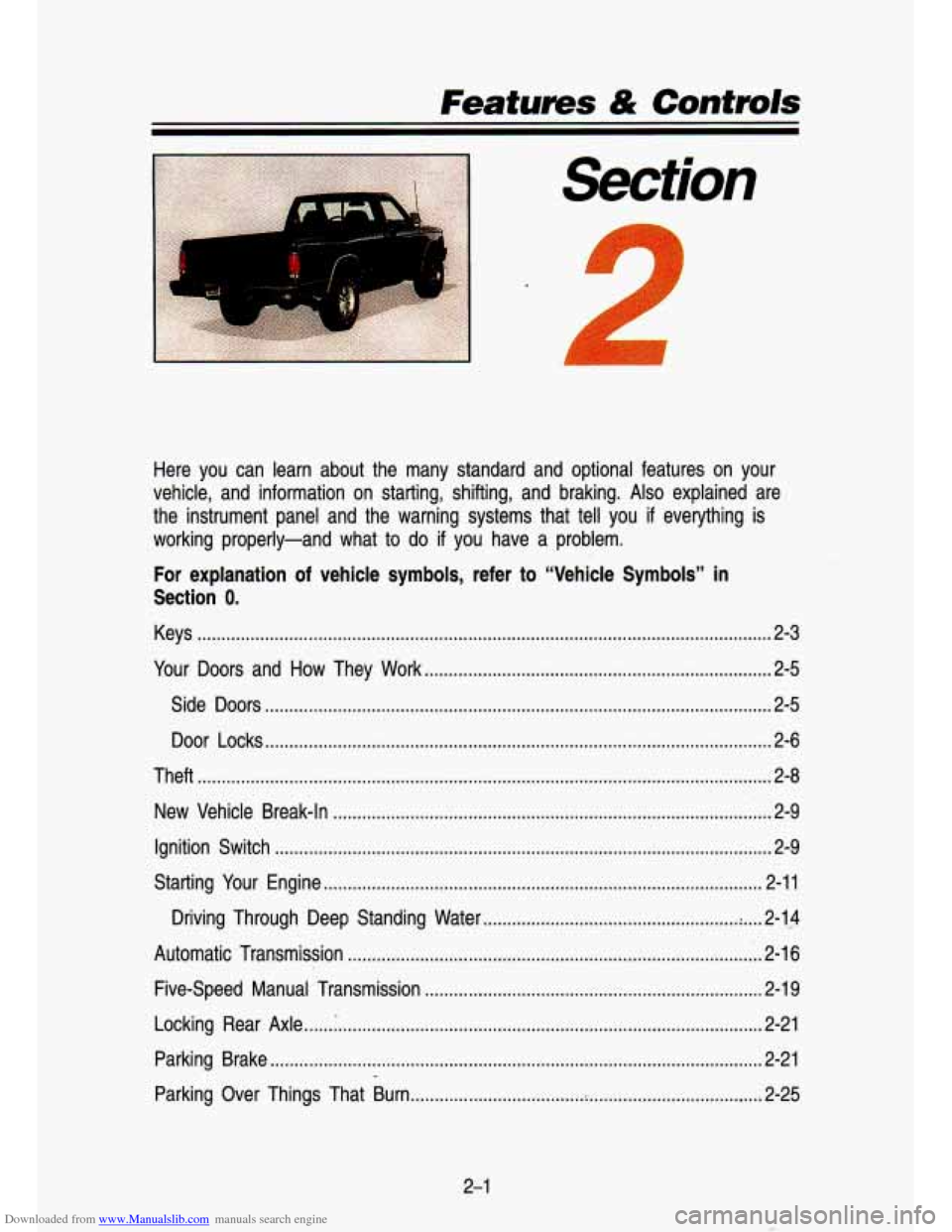
Downloaded from www.Manualslib.com manuals search engine Features & Controls
Here you can learn about the many standard and optional featur\
es on your
vehicle, and information on starting, shifting, and braking. Als\
o explained are
the instrument panel and the warning systems that tell you
if everything is
working properly-and what to do if you have a problem.
For explanation of vehicle symbols, refer to “Vehicle Symbols” in
Section 0.
Keys ......................,.........................,...........~...........\
...............................,...........,. 2-3
Your Doors and How They Work
............................................~.......................... \
2-5
Side Doors
.............I............r............................ .................................... .... ......... 2-5
Door Locks
........................................................................\
.................................. .- . , 2-6
Theft
........................................................................\
............................................... 2-8
New Vehicle Break-In
........................................................................\
............,...... 2-9
Ignition Switch
........................................................................\
............................... 2-9
Starting Your Engine
........................................................................\
................... 2-11
Driving Through Deep Standing Water
..................................................... .... 2-14
Automatic Transmission
........................................................................\
.............. 2-1 6
Five-Speed Manual Transmission ...................................................................... 2-1 9
Locking Rear
Axle ...... 1 ........................................................................\
................ 2-21
Parking Brake
........................................................................\
.............................. 2-21
Parking Over Things That Burn
........................................................................\
. 2-25
-
2-1
Page 60 of 356
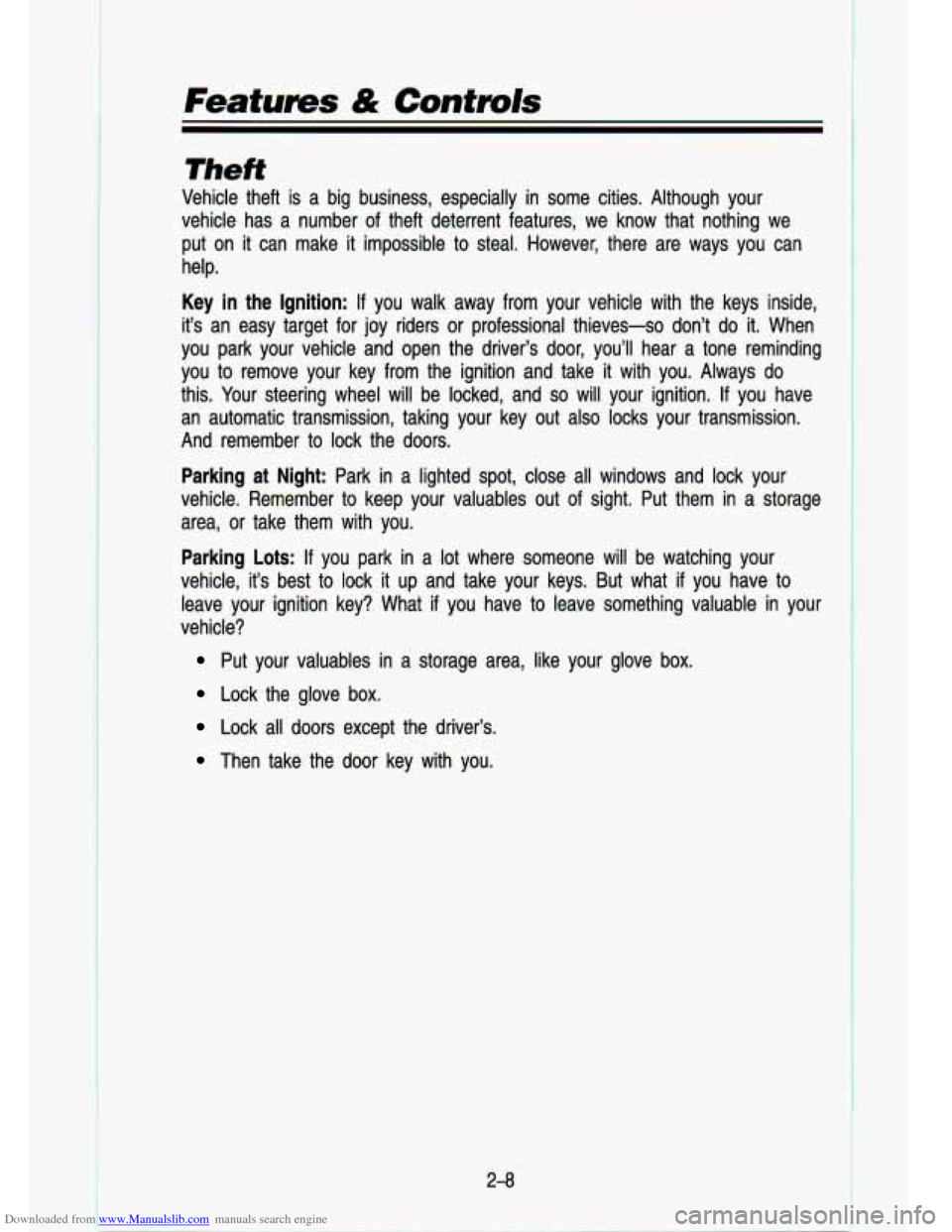
Downloaded from www.Manualslib.com manuals search engine Theft
Vehicle theft is a big business, especially in some cities. Although your
vehicle has a number of theft deterrent features, we know that nothing we
put on
it can make it impossible to steal. However, there are ways you can
help.
Key in the Ignition:
If you walk away from your vehicle with the keys inside,
it’s an easy target for joy riders or professional thieves-s\
o don’t
do it. when^
you park your vehicle and open the driver’s door, you’ll \
hear a tone reminding
you to remove your key from the ignition and take it with you. Always
do
this. Your steering wheel will be locked, and so will your ignition. If you have
an automatic transmission, taking your key out also locks your \
transmission.
And remember to lock the doors.
Parking at Night: Park in a lighted spot, close all windows and lock your
vehicle. Remember to keep your valuables out of sight. Put them in a storage
area, or take them with you.
Parking Lots:
If you park in a lot where someone will be watching your
vehicle, it’s best to lock it up and take your keys. But what
if you have to
leave your ignition key? What
if you have to leave somethina valuable in vour
vehicle?
Put your valuables in a storage area, like your glove DOX.
Lock the glove box.
Lock all doors except the driver’s.
Then take the door key with you.
2-8
1
Page 63 of 356
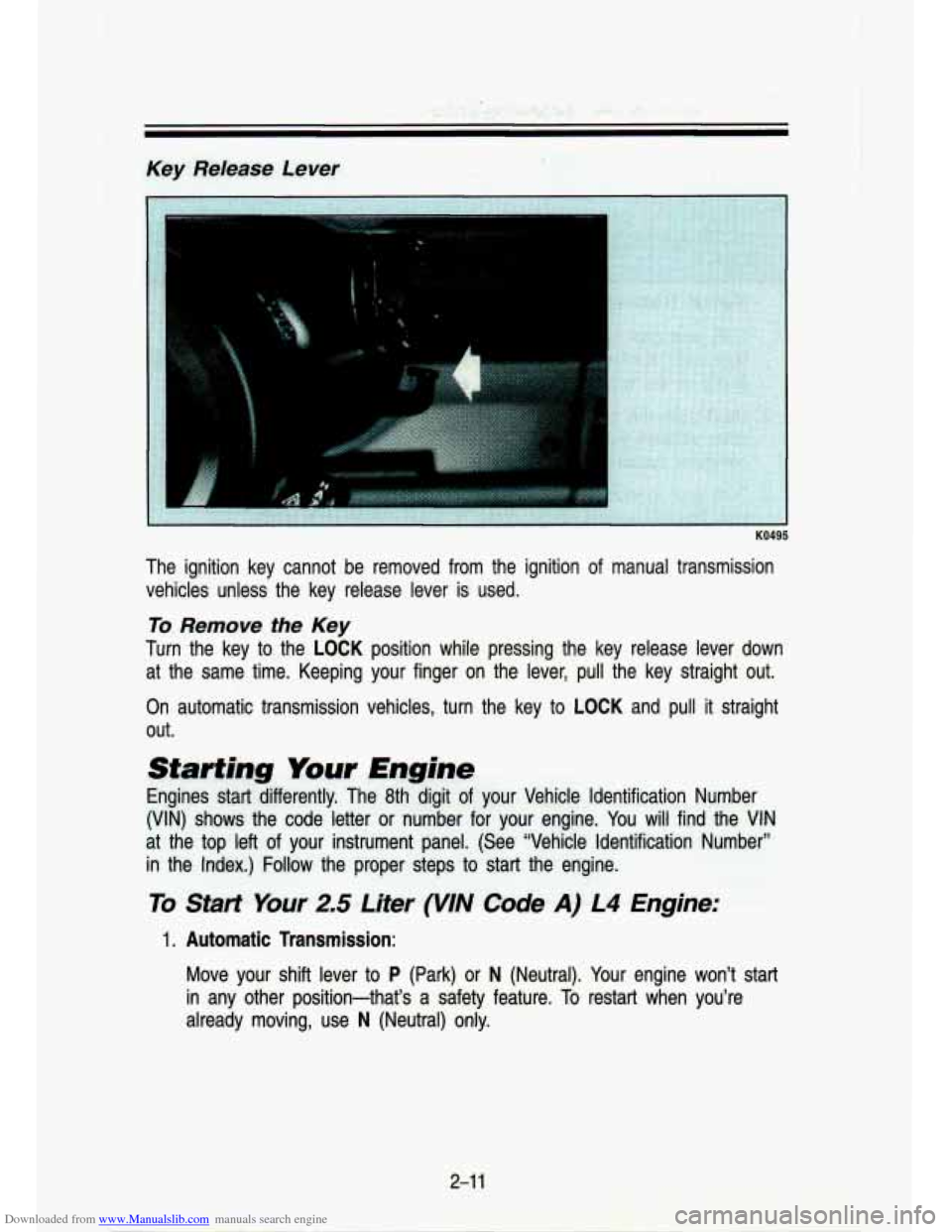
Downloaded from www.Manualslib.com manuals search engine Key Release Lever
The ignition key cannot be removed from the ignition of manual transmission
vehicles unless the key release lever is used.
To Remove the Key
Turn the key to the LO,CK position while pressing the key release lever down
at the same time. Keeping your finger on the lever, pull the \
key straight out.
On automatic transmission vehicles, turn the key to LOCK and p\
ull it straight
out.
To Starz Your 2.5 -Liter (VIN Code A) L4 Engine:
1. Automatic Transmission:
Move your shift lever to
P (Park) or N (Neutral). Your engine won't start
in any other position-that's a safety feature.
To restart when you're
already moving, use
N (Neutral) only.
2-1 1
Page 65 of 356
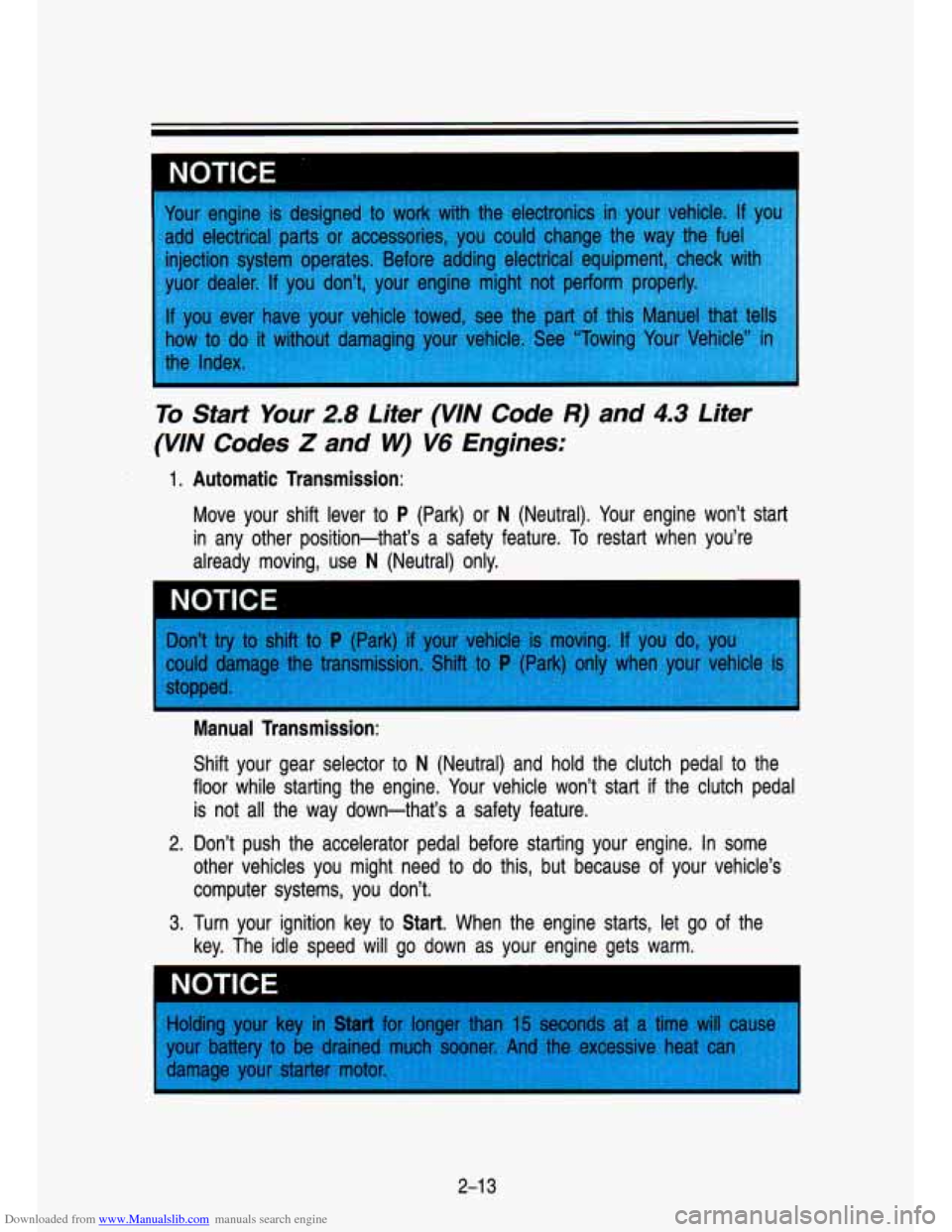
Downloaded from www.Manualslib.com manuals search engine NOTICE
I
ever nave your venue loweu, see 11
now IO do it without damaging your v-’-’cle
the Index.
To Start Your 2.8 Liter (W/V Code R) and 4.3 Liter
(VlN Codes Z and W) V6 Engines:
1. Automatic Transmission:
Move your shift lever to
P (Park) or N (Neutral). Your engine won’t start
in any other position-that’s a safety feature. To restart when you’re
already moving, use
N (Neutral) only.
I NOTICE
Manual Transmission:
Shift your gear selector to
N (Neutral) and hold the clutch pedal to the
floor while starting the engine. Your vehicle won’t start
if the clutch pedal
is not all the way down-that’s a safety feature.
other vehicles you might need to
do this, but because of your vehicle’s
computer systems, you don’t.
key. The idle speed will go down as your engine gets warm.
2. Don’t push the accelerator pedal before starting your engine. In some
3. Turn your ignition key to Start. When the engine starts, let \
go of the
I
2-1 3
Page 70 of 356

Downloaded from www.Manualslib.com manuals search engine Features & Controls
I
e
OD (Automatic Overdrive). This position is for normal driving. If you need
more power for passing, and you’re:
- Going less than about 35 mph (56 km/h), push your accelerator
pedal about halfway down.
- Going about 35 mph (56 km/h) or more, push the accelerator all the
way down. You’ll shift down to the next gear and have more power.
OD should not be used when towing a trailer, carrying a heavy load,
driving on steep hills, or for off-road driving. Select
D (third gear) when
operating the vehicle under any of these conditions.
D (Third Gear). This is like OD, but you never go into Overdrive. You
should use
D when towing a trailer, carrying a heavy load, driving on
steeps hills, or for off-road driving.
2 (Second Gear). This position gives you more power but lower \
fuel
economy. You can use
2 (Second Gear) on hills. It can help control your
speed as you go down steep mountain roads, but then you would\
also
want to use your brakes off and on.
If you have a 4.3L engine (Codes Z and W) and if you manually select
2, the transmission will drive in second gear. You may use this feature
for reducing torque
to the rear wheels when you are trying to start your
vehicle from a stop on slippery road surfaces.
1 (First Gear). This position gives you even more power (but \
lower fuel
economy) than
2. You can use it on very steep hills, or in deep snow or
mud. If the selector lever is put in 1, the transmission won’t shift into
first gear until the vehicle is going slowly enough.
2-1 8
Page 75 of 356
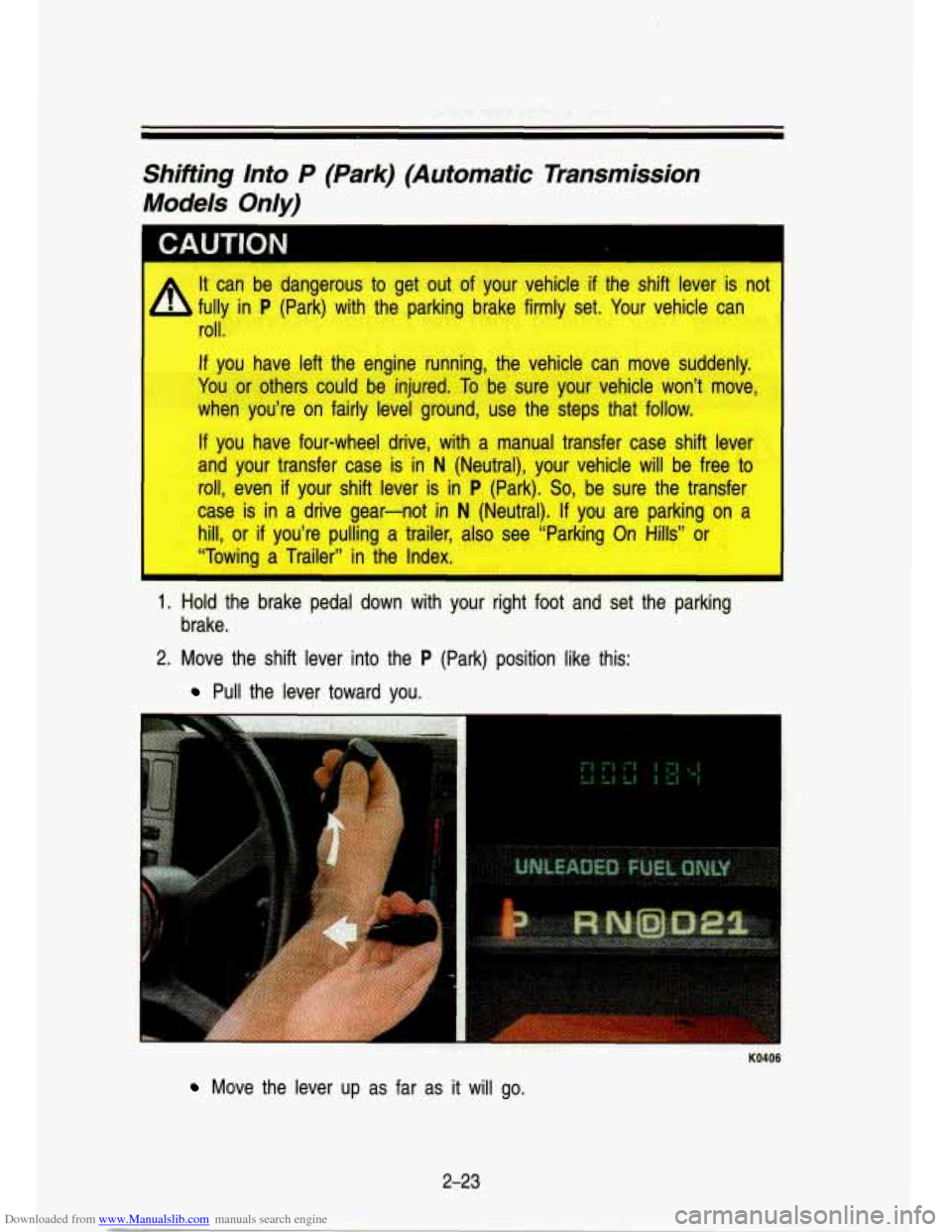
Downloaded from www.Manualslib.com manuals search engine Shifting Into P (Park) .(Automatic Transmission
Models Only)
fi A.UTION I.
It can be dangerous to get out of your vehicle if the shift lever is not I
fully in P (Park) with the parking brake firmly set. Your vehicle can
roll.
If you have left the engine running, the vehicle can move sudde..I,.
You or others could be injured.
To be sure your vehicle won’t move,
when you’re on fairly level ground, use the steps that foll\
ow.
If you have four-wheel drive, with a manual transfer case shif\
t lever
and your transfer case is in
N (Neutral), your vehicle will be free to
roll, even
if your shift lever is in P (Park). So, be sure the transfer
case is in a drive gear-not in
N (Neutral). If you are parking on a
hill, or
if you’re pulling a trailer, also see “Parking On Hills” or
“Towing a Trailer’’ in the Index.
1. Hold the brake pedal down with your right foot and set the parking
2. Move the shift lever into the P (Park) position like this:
brake.
Pull the lever toward you.
KO406
Move the lever up as far as it will go.
2-23
Page 76 of 356
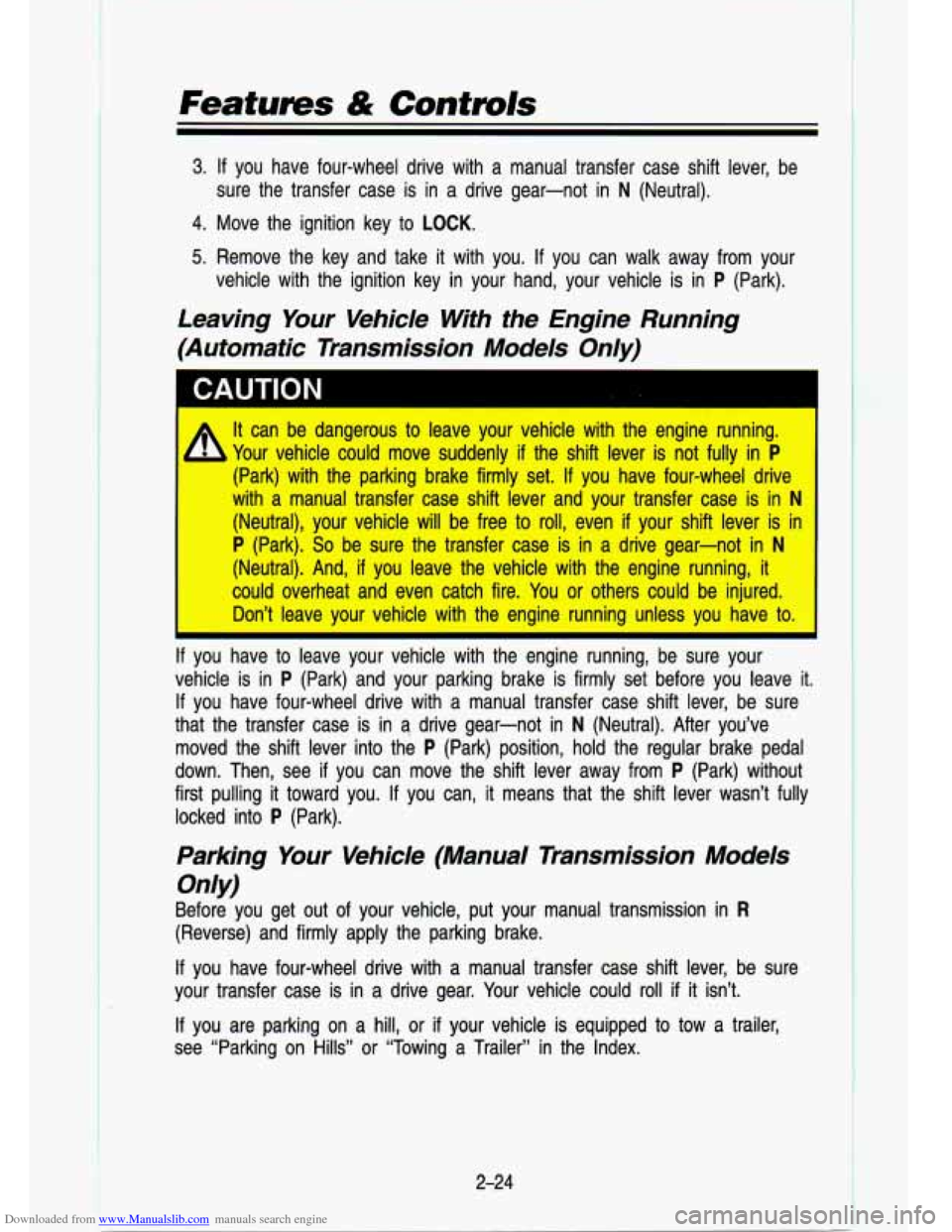
Downloaded from www.Manualslib.com manuals search engine Features & Contmls
3. If you have four-wheel drive with a manual transfer case shift\
lever, be
4. Move the ignition key to
LOCK.
sure the transfer case is in a drive gear-not in N (Neutral).
5. Remove the key and take it with you. If you can walk away from your
vehicle with the ignition key in your hand, your vehicle is in
P (Park).
Leaving Your Vehicle With the Engine Running
(Automatic Transmission Models Only)
1 CAUTION
It can be dangerous to leave your vehicle with the engine running.
Your vehicle could move suddenly
if the shift lever is not fully in P
(Park) with the parking brake firmly set. If you have four-wheel drive
with a manual transfer case shift lever and your transfer case\
is in
N
(Neutral), your vehicle will be free to roll, even if your shift lever is in
P (Park). So be sure the transfer case is in a drive gear-not in N
(Neutral). And, if you leave the vehicle with the engine running, it
could overheat and even catch fire. You or others could be injured.
I Don’t leave your vehicle with the engine running unless you have to.
If you have to leave your vehicle with the engine running, be sure your
vehicle is in
P (Park) and your parking brake is firmly set before you leave it.
If you have four-wheel drive with a manual transfer case shift le\
ver, be sure
that the transfer case is in
a drive gear-not in N (Neutral). After you’ve
moved the shift lever into the
P (Park) position, hold the regular brake pedal
down. Then, see if you can move the shift lever away from P (Park) without
first pulling it toward you.
If you can, it means that the shift lever wasn’t fully
locked into
P (Park).
Parking Your b bide (Manual Transmission Models
Before you get out of your vehicle, put your manual transmissi\
on in R
(Reverse) and firmly apply the parking brake.
If you have four-wheel drive with a manual transfer case shift le\
ver, be sure
your transfer case is in a drive gear. Your vehicle could roll
if it isn’t.
Only)
If you are parking on a hill, or if your vehicle is equipped to tow a trailer,
see “Parking
on Hills” or “Towing a Trailer” in the Index.
2-24
I
Page 78 of 356
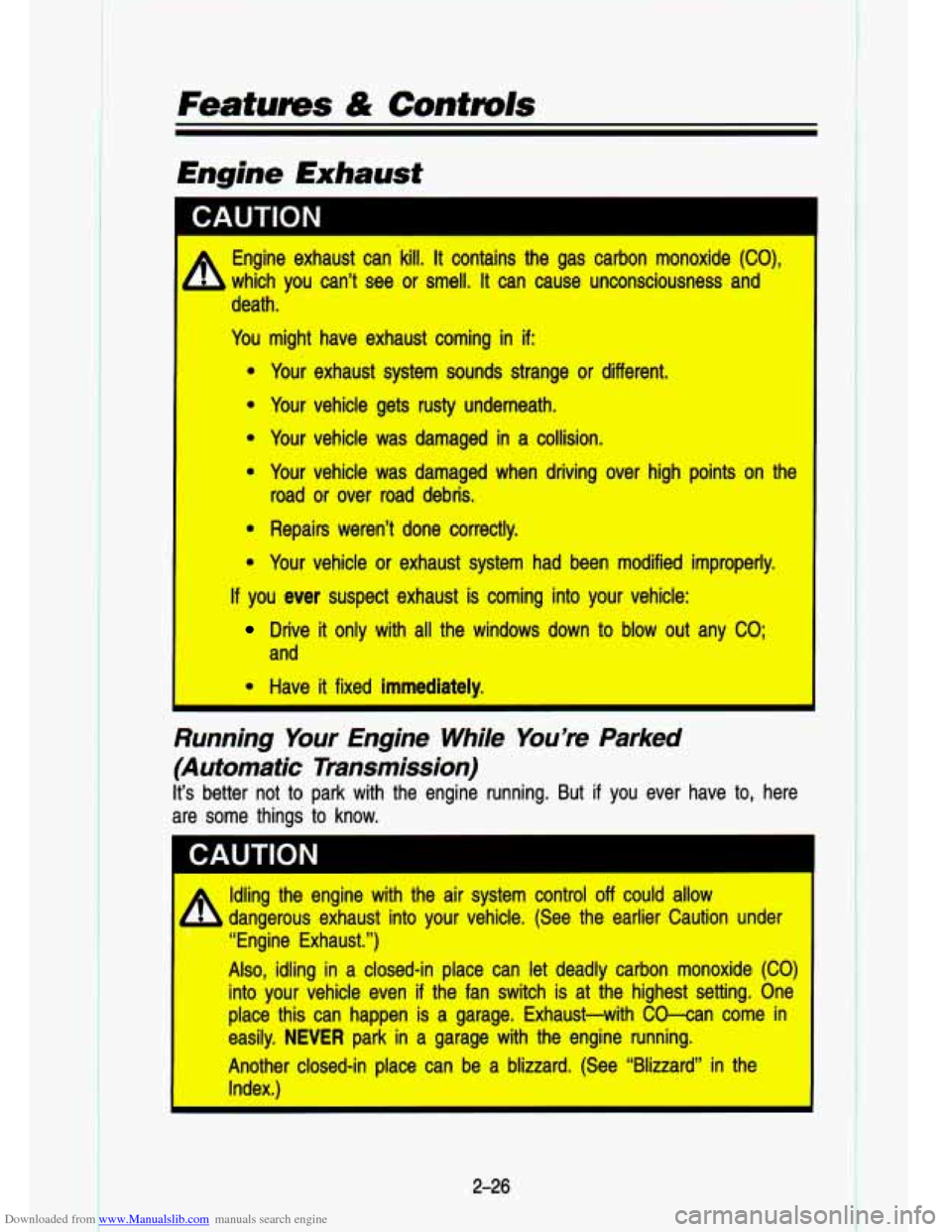
Downloaded from www.Manualslib.com manuals search engine Features & Contmls
I CAUTION
4
Engine exhaust can .kill. It contains the gas carbon monoxide (CO),
which you can’t see or smell. it can muse unconsciousness and
death.
You might have exhaust coming in if:
Your exhaust system sounds strange or different.
0 Your vehicle gets ‘rusty underneath.
* Your vehicle was damaged in a collision.
0 Your vehicle was damaged when driving ove’r high points on the
* Repairs weren’t done correctly.
0 Your vehicle or exhaust system had been modified improperly.
road
or over road debris.
If you ever suspect exhaust is comilng into your vehicle:
Drive il only with all the windows down to b’low out any CO;
* Have il fixed immediately.
and
Running Your Engine While You’re Parked
(Automatic Transmission)
It’s better not to park with the engine running. But if you ever have to, here
are some things to know.
I Ch1
Idling the engine with the air system control off could allow
dangerous exhaust into your vehicle. (See the earlier Caution \
under “Engine Exhaust.”)
Also, idling in a closed-in place can let deadly carbon monoxide (CO)
into your vehicle even
if the fan switch is at the highest setting. One
place this can happen is a garage. Exhaust-with CO-can come in
easily.
NEVER park in a garage with the engine running.
Another closed-in place can be a blizzard. (See “Blizzard”\
in the Index.)
2-26